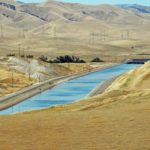
When Jay Wells noticed the City of Patterson was sinking another well in his neighborhood he sounded the alarm.
“I raised a fuss,” he said recently. “I was worried about over drafting.”
Like everyone in Patterson, Wells relies on groundwater for his residence and his business. He was worried that the City’s increasing demands would put too great a strain on the local aquifer. Patterson has over half a dozen wells, and continues sinking more as demand swells. Wells’ concerns were soothed after a conversation with the man he calls the City’s “water guru.”
Cort Abney has a Master’s Degree in engineering with an emphasis on water. As the City of Patterson’s water consultant, he’s learned a lot about groundwater in and around Patterson. Abney assured Wells that the City had drilled much deeper than the layer of water providing Wells’ water supply.
And, says Abney, “As far as we can tell, groundwater levels in the area have been pretty stable. There haven’t been severe fluctuations.”
Patterson’s dependence on ground water is typical of cities in the Northern San Joaquin Valley. However, despite what looks like a plentiful source of groundwater, Patterson is exploring a variety of other water sources.
“They’re aggressively pursuing all their options,” says Abney. “I think they are being thoughtful. They are being cautious. They have identified several feasible and affordable alternatives.”
The City of Patterson has good reason to be, “pursuing all their options,” if local movers and shakers have their way. That’s because the Patterson General Plan calls for exponential growth over the next few decades. The General Plan is a source of mild amusement among insiders in and around Patterson—the plan was paid for almost entirely by owners of land just outside the city—people who stand to profit handsomely if and when the City grows.
“They might have been a little overzealous,” says Jay Wells with a soft chuckle when asked about the General Plan.
Given Patterson’s current status as the Poster Burg for foreclosures, abandoned tract houses and depressed real estate values, the General Plan does seem a bit ambitious. During the building boom that began around the year 2000, Patterson’s population almost doubled from 11,606 residents to 21,000. According to the General Plan Update, “build-out of the General Plan will take 40+ years, resulting in an estimated population of approximately 67,000 persons and include 11,794 acres.” As we’ve noted here, many of those acres will be on a floodplain and include some of the best farmland in the world.
Patterson’s cautious approach to ensuring water supplies may be the result of an object lesson provided by Diablo Grande, a residential development just west of the City. Once touted by local media as a state-of-the-art resort featuring luxury residences, Diablo Grande has been plagued by water problems from its inception. The unlucky people who got in on the ground floor of the ill-fated scheme dealt with brown water and water-borne toxins for years. Those problems appear to have been solved, but hanging over their heads like the Sword of Damocles is a potentially worse situation.
Since water deliveries to Diablo Grande are from what the Department of Water Resources calls 2nd Priority water, Diablo Grande is subject to water reductions, especially during drought years. When the California Aqueduct underwent repairs in 2002, water was withheld from Diablo Grande for almost two months. The development has a backup well, but it’s deemed adequate only for
the very short term.
So even though Patterson’s groundwater supply seems more than adequate for now, Jay Wells’ concerns about over drafting were certainly justified given water supplies in general. A 2009 federal study revealed that the San Joaquin Valley has lost 60 million acre feet of groundwater since 1961—a drop in the aquifer level of almost 400 feet.
Among the many consequences of such a decline—none of them good—land subsidence is among the worst. Subsidence, or settling, is especially severe near Mendota, where an iconic photograph documents a drop of over 28 feet.
Drought, like the one we just passed through, is the primary cause for over drafting and the resultant subsidence. And once the land has sunk, it not only does not recover, the compacted aquifer is often too damaged to store water. Costs of subsidence in 1993 dollars were estimated at $180 million per year, according to the U.S. Geological Survey.
Another alarming effect of subsidence is drops in the levels of the California Aqueduct, the engineering marvel that helps make an Eden out of what was once a desert. So far, subsidence has only resulted in low spots in the aqueduct, but if the drop continues, as it’s bound to if we add more and more demand to the water supply, severe damage is inevitable. It would be a terrible irony if our 444 mile delivery system were to be damaged by the very demand it was meant to alleviate.
A premonitory lesson of just how bad things could get might be had from the example of the Coachella Valley, where the U.S. Geological Survey documented drops ranging from “3 to about 13 inches between 1996 and 2005 in an area stretching from Rancho Mirage to Coachella.” The possible consequences sound like episodes from a disaster film: According to the Riverside Press Enterprise, “the findings raise concerns that streets could buckle, sewer lines could break and trenches could appear in the earth if golf courses, residents and businesses don’t conserve enough water.”
And while the City of Patterson should be commended both for its due diligence in exploring a variety of water options and for its ranking among the most parsimonious per capita water users, it’s easy to forget that flogging the growth horse might not be the wisest way to assure the Valley’s future as the harvest basket of the nation.
Clearly driven for the most part by the desire for increased land values and jobs in real estate and the construction industry, it’s easy to forget that growth in the San Joaquin Valley hasn’t paid for itself for a long time. And if problems continue to arise from over drafting, subsidence, and its associated damages, it will be an already beleaguered public who pays, not the movers and shakers who’ve been promoting growth even in the face of empty houses, strained social services, layoffs of public servants and inadequate infrastructure.
“Everyone wants his land value to go up,” says Jay Wells. Thus far in the Valley’s history, that desire has been an irresistible force, despite abundant signs of trouble ahead.

Thanks, Eric, for all you do to enlighten the public. Education is necessary for any democracy; food is one of the 4 needs of all humans, the other 3 being air to breathe, good water and shelter. Shelter seems to to abundant if you look at the statistics. Air, water and soil to grow our crops should be #1 priority in planning.
Our Valley is one of 6 places in the world that has the Mediterranean climate, water and excellent soil: parts of India; South Africa; Chile, Australia, northern Mediterrean and our Central Valley in California. We can’t afford to continue the path we are on. Keep up the good work.
I have worked around the country and the world. I have found in other areas they have documented the “recharge” capability of their aquifers and do not draw more than what can be recharged. Does California have such an inventory? If so, I see no controls on pumping that would accompany such an inventory.
To the best of my knowledge there are no controls on California ground water of any kind.
I suggest adding a facebook like button for the blog!
Helen
It’s on the landing page, right column.